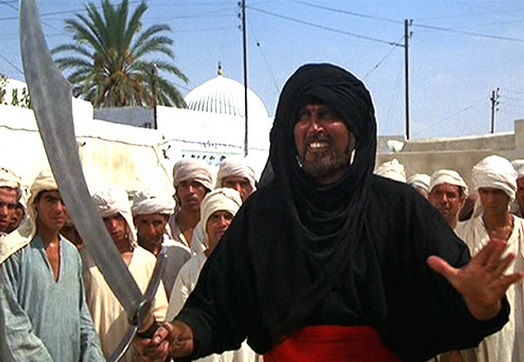  |
 |
 |
 |
|
MahdiWatch.org
|
 |
|
Home | About Me | Links to My Articles | Info on My Books | Contact Me
|
 |
|
Welcome to MahdiWatch.org! NEWSFLASH! COMMENTS LINK
BELOW EACH POST IS ENABLED! FEEL FREE TO BURY ME, PRAISE ME--OR JUST ISSUE A PERSONAL FATWA!
al-Mahdi is "the rightly-guided one" who, according to Islamic Hadiths (traditions),
will come before the end of time to make the entire world Muslim. Over the last 1400 years numerous claimants to the
mantle of the Mahdi have arisen in both Shi`i and Sunni circles. Modern belief in the coming of the Mahdi has
manifested most famously in the 1979 al-`Utaybi uprising of Sa`udi Arabia, and more recently in the ongoing
Mahdist movements (some violent) in Iraq, as well as in the frequently-expressed public prayers of former Iranian
President Ahmadinezhad bidding the Mahdi to return and, in the larger Sunni Islamic world, by claims that Usamah bin Ladin
might be the (occulted) Mahdi. Now in 2014 Mahdism is active in Syria, as the jihadist opposition group Jabhat al-Nusra
claims to be fighting to prepare the way for his coming; and in the new "Islamic State/caliphate" spanning
Syrian and Iraqi territory, as its leadership promotes the upcoming apocalyptic battle with the West at Dabiq, Syria. This site will track such Mahdi-related movements, aspirations, propaganda and beliefs in both Sunni and Shi`i
milieus, as well as other Muslim eschatological yearnings.
For a primer
on Mahdism, see my 2005 article, "What's Worse than Violent Jihadists?," at the History News Network: http://hnn.us/articles/13146.html; for more in-depth info, see the links here to my other writings, including my book on Mahdism.
|
|
|
|
Sunday, May 31, 2015
Islamophobia, Iconophobia, and Islamic Images of Muhammad
The rather obscure realm of Islamic art, and in particular whether it’s “unIslamic”
to portray Islam’s founder, Muhammad, therein, has become an important—indeed, potentially lethal—topic,
first with the murders of the Charlie Hebdo publishers, then with the Garland, Texas, attack on the organizers of “Draw Muhammad” which resulted in two self-styled jihadists being dispatched to consort with the houris. The brains behind “Draw Muhammad”—Robert Spencer and Pamela Geller—inspired another similar event in Phoenix this past Friday (May 29, 2015). Geller, the lightning rod of the Spencer-Geller counter-jihad duo, recently mixed
it up on CNN with Chris Cuomo, as the latter compared her push for people to draw Muhammad with using the “n-word” in referring to black Americans. 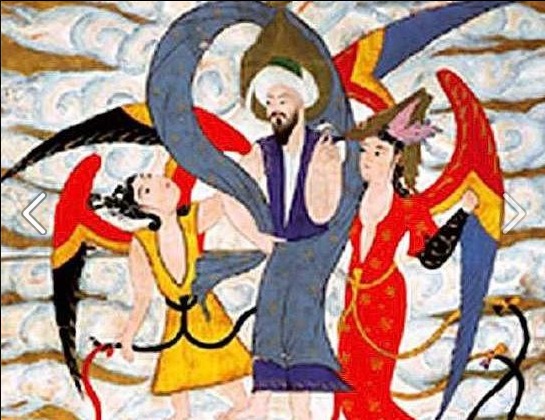 Muhammad cavorting with houris, from the Ottoman palace museum--THIS should upset Muslims
more than anything from "Draw Muhammad." Muhammad cavorting with houris, from the Ottoman palace museum--THIS should upset Muslims
more than anything from "Draw Muhammad."
Whether one
feels that “Draw Muhammad” events are intentionally provocative,it’s clear that they are certainly legal on First Amendment grounds—so I do not wish to rehash that debate. Rather, I think it more important to examine the history of Islamic attitudes
toward art in general and the portrayal of humans, particularly prophetic figures, in particular. Media experts are
all over the map on this issue: some maintain that images of Muhammad are strictly forbidden in the world’s second-largest religion, while others argue that “the koran [sic]” does no such thing. For a reasoned and exhaustive take, yet one accessible to
us philistines, I have turned to the chapter “The Visual Arts in an Islamic Setting, c. 1258-1503,” pp. 501-520
in The Venture of Islam: Conscience and History in a World Civilization: The Expansion
of Islam in the Middle Periods by the brilliant historian Marshall G.S. Hodsgon. Hodgson situates the topic into the the long history
of the “Irano-Semitic lands,” and of the monotheistic religions therein, and pegs the distaste for visual symbolism—particularly
of humans, and even more specifically of those deemed prophets—to a rejection by Jews, some Christians, and later Muslims
for the “figural images” which were a staple of non-monotheist nature cults in the Middle East. This “iconophobia” is not spelled out in the Qur’an,
true; but Islam’s intense focus on abstract monotheism derived from the Qur’an meant that “any other symbolism,
particularly in such seductive forms as music and visual imagery, must appear as a rival to the Qur’anic presence.” Thus, “Shar’iah-minded Islam” eventually
“banned all figural imagery…on the ground that it might tempt the weak to idolatry. Hanafi and Usuli [Twelver]
Shi`i law books banned images…Shafi`is and Malikis implicitly linked art to luxury...but they all came to like conclusions”—contra artwork that showed holy humans, that is. The Hanbali school of jurisprudence, which did
not develop until centuries later, doubled (at least!) down on this artistic puritanism (Wahhabism and Salafism stem from
Hanbalism); it is from this particular Islamic interpretive ideology that most of the world’s terrorists now come—including
the al-Qa`idah-linked killers in Paris, and the ISIS destroyers of any and all art which they can get their bloody jihadist
hands on. 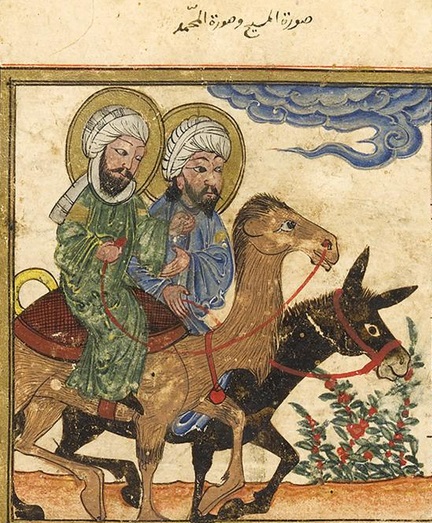 Jesus and Muhammad, the original easy riders. Neither seems too uptight about being painted. Jesus and Muhammad, the original easy riders. Neither seems too uptight about being painted.
There are those who got around the portrayal prohibition—especially
in the areas of the Islamic world conquered by the Mongols, to which less restrictive ideas about painting and imagery were
exported from the Far East, particularly China. In Afghanistan and Persia, in particular, and between 1300 and 1600 AD, “miniatures” which portrayed humans—as
well as prophets, up to and including even Muhammad—were allowed, and often even patronized by Islamic rulers. Even in the central (Arab)
Islamic lands, the Shari`ah-minded “iconophobia” was not the only perspective: often at loggerheads with that
was Sufism, the broad, mystical movement more concerned with inner than outer piety, and thus not always averse to depictions
of prophets and other holy figures. But In so far as the Shari`ah-minded have come, since 1600 AD, to dominate Islamic thinking and adjudicate acceptable Islamic piety—“where
if a peasant came upon ancient paintings or statues he was likely to destroy them at once, or even a scholar (with the sanction of fiqh law) might actually draw a line
across the throat of a painted figure to show that it was not alive”—the Sufis (who number perhaps 100 million,
all told) now comprise not just the numerical but the ideological minority.
So does Islam ban portrayals of its founder, Muhammad? Yes—and
no. The majority opinion of Muslims—certainly
of the `ulama, the cleric-scholars, in all five major
interpretive schools—is that it is “idolatrous” to paint/illustrate any human, much more Jesus or Muhammad. However, it is also quite clear
that such depictions were done in
the past by Muslim artists, and thus that the Shari`ah-minded consensus of the last 400 years could very well be rolled back
to what held before that—if Muslims were willing to give the Sufi side of Islam another chance. Until then, while it is not true that cartoons of Islam’s founder are the visual equivalent
of the “n-word,” a more effective means of exposing the majoritarian intolerant strain of Islam might be to eschew
modern drawings of Muhammad (and certainly intentionally insulting ones) and, rather, stage exhibits with examples of ISLAMIC paintings of him. That would make the point more historically and legitimately, and less
provocatively, in my opinion. 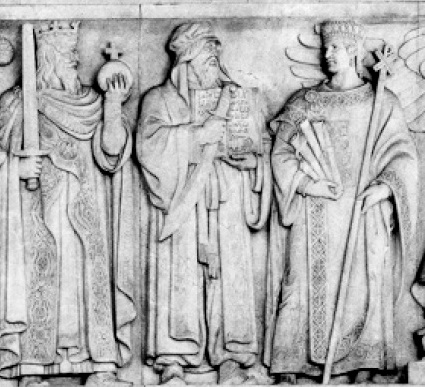 Muhammad "the Lawgiver" flanked by two others a bit more relevant to Western civilization:
Charlemagne and Justinian. Why haven't Muslims rioted over this graven image on the US Supreme Court building? Well,
the millennium IS young.... Muhammad "the Lawgiver" flanked by two others a bit more relevant to Western civilization:
Charlemagne and Justinian. Why haven't Muslims rioted over this graven image on the US Supreme Court building? Well,
the millennium IS young....
[The three images used on this page all
come from the "Mohammed Image Archive" at zombietime.com)
Saturday, May 30, 2015
Debating Islam and Eschatology at Boston University
Having been out of town recently, I fell behind in posting videos from our early May conference at
BU. Herewith I shall catch up. First, here is the Q & A which followed panel 1 (Richard Landes, Will McCants and Graeme Wood--already linked earlier on this site). Then, Charles Cameron, futurist extraordinaire and perspicacious blogger, had the unenviable task of trying to pull together, thematically, panel 2 (my talk on Ottoman responses to
to Mahdists, Cole Bunzel's discussion of the 1979 al-Utaybi uprising, and Jeffrey Bale's merciless exposure of Western "useful
idiocy" regarding Islam--all of which, again, are already linked, below). He did so admirably, even adducing the messianic themes in "Dune!" That gets us up
to panel #3, the first lecture of which--David Cook's on "ISIS and Boko Haram" I have already posted. The
other two lectures in that grouping were the Brookings Institute's J.M. Berger on "The Role of Communications Technology in Mediating Apocalyptic Communities" and Professor Michael Pregill's on "Shi`i Militancy, Apocalyptic Islam, and Othering the Other." The latter's talk was quite...interesting. Pregill is an "interlocutor" at BU (which
seems to be some sort of faculty position) and clearly a learned man on the topic of early Islam. The part of his lecture
that dealt with the Fatimids, the medieval Severn Shi`i movement that ruled Egypt for several centuries, was quite fascinating
and enlightening. However, Mr. Pregill seemingly could not resist the urge to politicize the issue at hand--even, at
one point, likening the Jesus-will-return eschatology of Evangelical Christians in the Tea Party to ISIS. One wonders
why such an intelligent person feels impelled to drag in not only an irrelevant, but an illogical, analogy. And, finally (for now) here is the Q & A which followed panel #3. 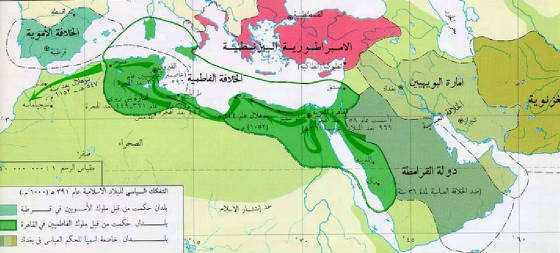 The Fatimid Empire (the dark green blob stretching across North Africa). What it has
to do with the Tea Party is anyone's guess. The Fatimid Empire (the dark green blob stretching across North Africa). What it has
to do with the Tea Party is anyone's guess.
Wednesday, May 27, 2015
Will the Mahdi Bless the Rains (of Terror) Down in Africa?
Another fine lecture from our Boston University conference on Islamic apocalyptic is up: Dr. David Cook,
probably the world's foremost expert on Muslim eschatological hadiths, spoke on "ISIS and Boko Haram: Profiles in Apocalpytic Jihad."  Abubakr Shekau, head of Boko Haram--and potential wazir (prime minister) for Mahdi al-Baghdadi? Abubakr Shekau, head of Boko Haram--and potential wazir (prime minister) for Mahdi al-Baghdadi?
Thursday, May 21, 2015
Nowhere Man--American Policy Toward Islam Is At Your Command
One of the best lectures from the Boston University conference on Islamic apocalyptic is up--although it
does not, ironically, really deal with the main topic of the venue. Dr. Jeffrey Bale, eminent expert on terrorist ideologies
across the board at the Middlebury Institute of International Studies at Monterey (CA), talked about "Refusing to Take Islamist Ideology Seriously." John Lennon's lyrics, "he's as blind as he can be/just sees what he wants to see," aptly describe (too) many analysts of jihad and terrorism today--and Jeffrey Bale lays out the ideological
blinders of these Nowhere Men and Women. 
"Dry Bones" nails it--as usual!
Wednesday, May 20, 2015
Apocalypse Now and Then
Today a dual helping of Mahdist-related posts shall be served up. First, another
lecture from the Boston University conference is now available: Cole Bunzel, a PhD candidate at Princeton University, examined
the 1979 Mahdist coup manque in Saudi Arabia, in "From Apocalypse Now to Caliphate Now: Revisiting Juhayman al-`Utaybi's Siege of Mecca in 1979." (I also covered some of the same ground in Holiest Wars, as well as in an article in "The
Weekly Standard" in 2008: "Enter the Mahdi." Second, I was interviewed for an hour yesterday by Hezi Aris on WHYT (Westchester, NY); topics covered: Mahdism, ISIS, and Middle Eastern politics (particularly
the situation in Turkey).  The Casbah, er, Great Mosque getting rocked by al-Utaybi and his brother-in-law, the Mahdi. The Casbah, er, Great Mosque getting rocked by al-Utaybi and his brother-in-law, the Mahdi.
Tuesday, May 19, 2015
The COIN of the Ottoman Realm Spent Against Proto-ISIS Groups
My lecture from the Boston University conference on Islamic apolcalyptic movements, "Rejecting Millennial Time: The Ottoman Empire's 700-year War against Mahdism" is up. Its two main points are that 1) eschatological/Mahdist groups are not new with ISIS, but have
been around for centuries; and 2) the counter-insurgency (COIN) methods employed by the Sunni Ottoman state to fight such
Islamic challenges to its rule are instructive for Muslim regimes today. 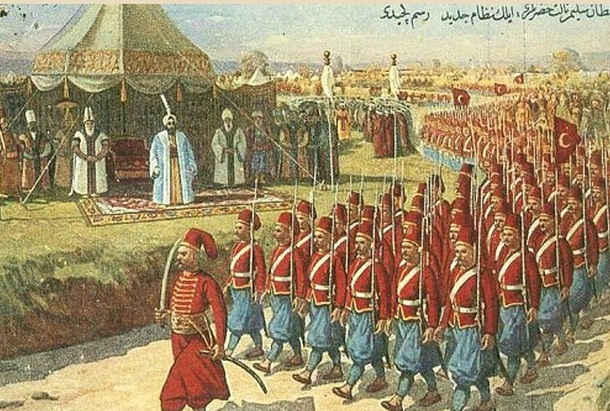 The usual Ottoman kinetic response to Mahdist rebellions started with the janissaries--but
often this was supplemented with IO/IW in the form of fatwas and other religious salients. The usual Ottoman kinetic response to Mahdist rebellions started with the janissaries--but
often this was supplemented with IO/IW in the form of fatwas and other religious salients.
Friday, May 15, 2015
ISIS' Islamic Apocalyptic Mindset Examined in Depth
7:16 am edt
Wednesday, May 13, 2015
Prepare Ye the Way of the Mahdi....Conference
The first video from the Boston University conference "Apocalyptic Hopes, Millennial Dreams and Global
Jihad" (May 3-4, 2015) is up: Dr. Richard Landes, conference organizer and former head of BU's Center for Millennial
Studies, lays the groundwork and sets the parameters for the entire conference. 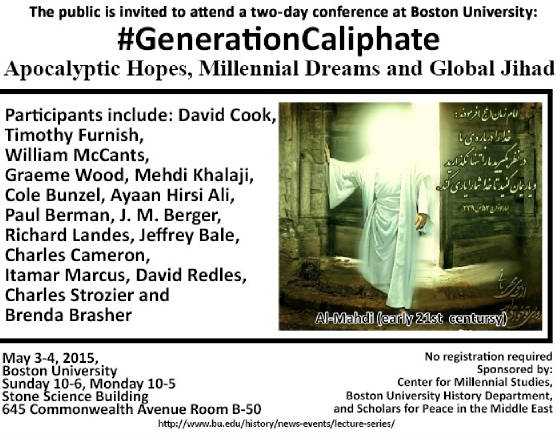
Monday, May 11, 2015
Arguing Like It's the End of the World: Academics on Islamic Apocalyptic
My after-action report on the Boston University conference, "Apocalyptic Hopes, Millennial Dreams and Global Jihad,"
has been published at History News Network under the title "Talking Honestly about Islamic Hate Speech." As I note at the end of that piece, video of the conference presentations is being prepared, and as soon as it is
available I will link such here. 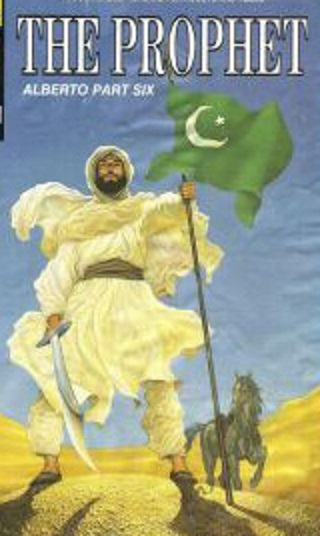 "The Prophet" as portrayed in "Chick" comics (courtesy of zombietime.com) "The Prophet" as portrayed in "Chick" comics (courtesy of zombietime.com)
Wednesday, May 6, 2015
Lone Wolves, Stray Dogs or Roaming Hyenas? A Modern Terrorist Bestiary
The bodies of ISIS epigones Elton Simpson and Nadir Soofi had not yet even fallen to room
temperature before the mainstream media was braying about them being “self-radicalized” terrorists—a liberal obsession by now, despite recent eviscerations (like this) of that myopic analytical lens. A “self-radicalized”
(Islamic) terrorist is almost always, as well, labeled a “lone wolf.” I dealt with this issue in an article about the Boston Marathon-bombing Tsarnaevs, back in spring 2013: “[I]t is no longer necessary to be formally
attached to a terrorist organization in order to engage in Islamic-based terror. Heretofore, solo jihadists were likely
to be identified as exhibiting ‘Sudden Jihad Syndrome’ or as being ‘lone wolves.’ Now
the neologism ‘stray dogs’ is being applied to them. The first term at least has the virtue of acknowledging
the Islamic element in attacks by Muslims who say they are engaged in, well, jihad. But no one suddenly decides to ascribe
to Islamic holy warfare and wage it; only a fairly long process of indoctrination can bring a person to that point. A
lone wolf is a terrorist who takes up his bloody trade sans formal support from any larger group….The classification of stray dog, however, posits ‘men for whom Islam as a religion is less important than the search for adventure and a desire to be
part of a historic, epic struggle’---striking me as yet another attempt by analysts to remove Islamic ideology from
the calculation, for apologetic and emotional rather than rational reasons….[thus] viewing [Islamic terrorists]…analytically,
as lone wolves, may give them too much credit; while classifying them as stray dogs
neutered of religious ideology gives the Islamic element too little. Perhaps a new paradigm, one of roaming
hyenas, best describes [such violent Muslims]….” Hyenas,
like wolves, hunt in packs; but the former are more often scavengers who, if they do attack the living, prefer to go after
weakened prey (while the latter will pursue more formidable foes). 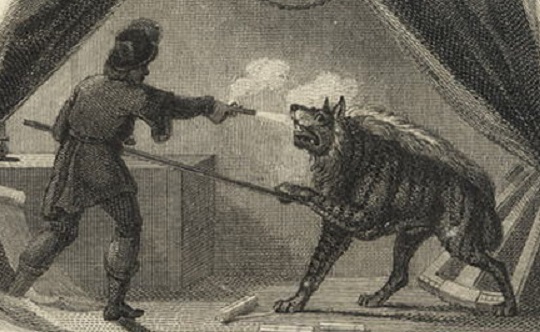 The proper care and feeding (hot lead) of an attacking hyena.... The proper care and feeding (hot lead) of an attacking hyena....
What better way to describe ISIS, as well as its minions in the West—especially as
ISIS has specifically called for attacks against unarmed “Crusaders” (rather an oxymoron, that), in “Dabiq” issue #4: “At this point in the crusade…it is very important that attacks take place in every country that has entered
into alliance against the Islamic State, especially the US, UK, France, Australia and Germany….the citizens of crusader
nations should be targeted wherever they can be found. Let the muwahhid not be affected by ‘analysis paralysis’
stemming from undertaking only operations that cannot fail. ‘He should be pleased to meet his Lord even
if with just one dead kafir’s name written in his scroll of deeds.’” IS
even doubles down on this incitement to jihad: “Every Muslim should get
out of his house, find a crusader, and kill him. It is important that
the killing becomes attributed to…the Islamic State…. Otherwise, crusader media makes such attacks appear
to be random killings.” Exhortation to jihad in the West fi sabil Allah goes on:
“If you can kill a disbelieving American or European—especially the spiteful and filthy French—or an Australian or a Canadian or any other disbeliever…wag[e] war…then rely upon Allah, and kill him
in any manner or way….Kill the disbeliever whether he is civilian, or military….” Hyenas follow the pack mentality (Qur’anic- and Hadith-literalist, violent Islam); cravenly prefer to
assault the weak or unarmed (Christians in the Middle East; cartoonists in Texas); and are known to feign death to escape
being killed themselves (a self-serving, duplicitous animal form of taqiyya). Furthermore, hyenas have a very negative image in Islam—all the more reason to apply that label to those who would kill in the name of Allah. They also suck—literally,
at least in east Africa, where hyenas are believed to hoover up jinn. Whether hyenas, four- or two-legged, are thereby possessed by such spirits is a topic for another day (although
I have touched on this topic, at least tangentially, before).
|
|
|
|
| Jamkaran Mosque near Qom, Iran (during my trip there Aug. 2008) |
|
|
|
